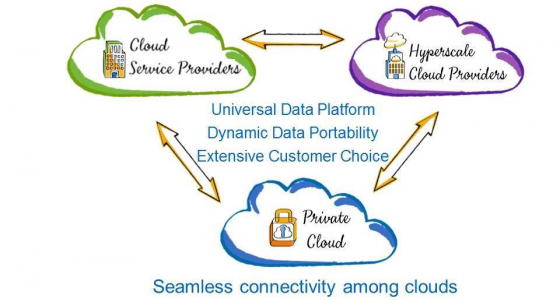In the already overhyped cloud market, hybrid cloud computing is emerging as the next big thing. In many cases, it’s happening organically over time. Even as enterprise-sized media operations are deploying private clouds to increase agility and reduce costs for media workloads, they are also steadily increasing the number of IT workloads being run in public clouds. This is helping them in three key areas: test and development, burst media processing (typically transcoding), and ongoing growth of the business. IT managers have become unwitting intermediaries between their companies and cloud service providers, managing workloads and moving data among multiple clouds.
When the dust settles, the companies that have deployed a well-thought hybrid cloud strategy will come out ahead, so it behooves you to take a step back and consider all the variables. To get past the current hype, you should assess how the cloud fits into your IT road map, and determine which of its many forms makes sense (and which don’t) for your operations. Some recommendations:
Consider data portability between workgroup storage, enterprise storage, enterprise private cloud storage, and public cloud back-up offerings.
The ability to manage data seamlessly in a hybrid cloud environment can give you new degrees of freedom for balancing and fine-tuning data services across cloud resources. Your operations teams already benefit from managing virtual machines. Having a common set of storage services will enable them to provision resources and manage data more effectively across multiple cloud environments.
Look for a storage operating system that is designed to provide that common data platform and serve as the data management foundation for a hybrid cloud environment. A common set of storage services can address one of the more complicated aspects of brokering services between private and public cloud resources —data management — with a platform that offers a common data format and familiar management among resources. With such a platform in place, your organization can move data around dynamically among cloud resources, creating innovative cloud solutions and avoiding cloud-provider lock-in. Regardless of what storage you go with for future on-premise needs, pick a storage vendor with proven technologies that streamline data movement, making it easy for you to move data from their storage systems to the cloud and back again.
Design private cloud services with a hybrid future in mind. Make sure future integration/interoperability is possible.
The idea is to position the IT organization so that managers can choose among cloud services, knowing that for whatever reason — change in business needs, policies, location, etc. — they can make adjustments with minimal pain and impact to the business.
In the rapidly evolving world of cloud computing and storage, you have many opportunities to demonstrate leadership by developing a road map that employs advanced cloud infrastructures to support business objectives and carve out competitive advantage. Once you’ve assessed your short- and long-term IT goals, you’ll need to evaluate competing cloud offerings to determine which services are compatible with user requirements, including such important criteria as latency, performance, and SLAs. Finally, you should interview potential cloud providers, check customer references, and negotiate business terms. By going through these steps, you help ensure that the services you put in place will be able to evolve and change shape in order to meet the needs at hand. And just as importantly, you help ensure that all of the services will work together seamlessly between on- and off-premise locations.
Embrace your role as a cloud services broker.
IT managers in larger media operations will gradually become “cloud services brokers” that manage across private clouds within their own data centers, among hyperscale cloud providers such as Amazon (AWS), Google, and Microsoft, and across large public cloud service providers such as Softlayer Rackspace, Orange Business Services, and Verizon. Media companies will benefit because the competition among market-leading cloud service providers is creating a broad range of new options and price points for the delivery of IT and media services.
Think of cloud services as another technology. Just because the cloud is disruptive doesn’t mean it is best for every application and use case. Some applications and use cases would benefit greatly from a “pay-as-you-go” approach and therefore should be considered for the cloud earlier. In use cases that require a large amount of data (media), however, the workflows might be too “heavy” to move easily to the cloud. In those cases, it’s best to wait or take advantage of a hybrid cloud model. After all, it isn’t just about where you store your media and business data. It’s also about moving, migrating, and managing your data. Those costs are actually greater than the purchase or rental of the storage capacity itself.
Transitioning from managing workgroups to managing internal private clouds to integrating with public clouds is not a simple process. As cloud environments increasingly evolve into a blend of different types with multiple vendors, your role as an IT cloud services broker — whether intentional or accidental — will continue to grow in importance. Yours is a challenging and rapidly evolving environment that will require extensive IT experience, cloud knowledge, and well-honed negotiating skills when you’re hammering out deals that include such major issues as data control and management, consistent SLAs, and security. You must learn to hide the complexities of hybrid clouds from business units while supporting an agile, best-of-breed approach that optimizes their investments in both private and public cloud resources.
Even as you’re considering all the variables, understand that this is an iterative process that will need to be repeated as needs evolve and new options become available. The payoff will be a more agile media organization that is well positioned to boost business performance to unprecedented levels.
Thought Gallery Channel:
Thought Leaders
